How to spot five planets in the sky
Loading...
As the planetary (almost) alignment that began Jan. 20 continues, sky watchers should expect an even better show in the coming weeks, because elusive planet Mercury will be higher and more visible than before.
The rare parade of planets, jointly visible to the naked eye for the first time since 2005, will be at its prime in the first two weeks of February, before Mercury descends towards the rising sun.
"At present, all the planets other than Mercury are visible in the pre-dawn sky," said Arvind Paranjpye, director of Nehru Planetarium, told Maine News Online. "Mercury joins the party in the first week of February."
All five planets will remain visible until about February 20, but astronomers say the best view is likely to be on the morning of February 5, according to the Telegraph.
Want to have a prime view of the cosmic quintet? Astronomers have some pro tips for you.
The best time to see the alignment is just before dawn, because as soon as the sun comes up, it becomes too bright to see the planets. (Check online to find out sunrise in your town.)
Jupiter will rise first, followed by Mars. Spotting the Red Planet between Spica and Antares will be easy thanks to its brightness and trademark reddish color. Saturn rises next, northeast of the bright red star Antares, shining even more brightly than Mars. Venus will be quite low in the southeastern sky, but its brightness makes it easy to spot. Mercury is the last of the planets to rise, so it will be quite low in the southeast as morning twilight grows brighter.
To have a good view of the alignment you will need to have an unobstructed southeastern view, away from any trees or tall buildings.
First look for Venus, the brightest of the quintet, located fairly low above the horizon. To spot Mercury, look to the lower left of Venus, where it will appear as a distinct "star" in the glimmering dawn light. To find the other three planets, sweep your gaze in a long arc to the upper right from Venus. First comes Saturn, which is much dimmer than Venus. Red Mars comes next and finally, look well past the bright star Spica to bright Jupiter high in the southwest. The entire arc of five planets stretches more than halfway across the sky, according to Silive.com.
Jason Kendall, on the board of the Amateur Astronomers Association of New York, had this advice for watchers: “Close one eye, stretch out your arm, and slowly pass your thumb over a bright dot in the sky. If the dot slowly dims out when your thumb passes over it, it’s a planet. If it quickly blinks out, it’s a distant star,” he told the New York Times.
If you miss the alignment, you can catch it again in August of this year, and after that, the five planets will not be seen together again until October 2018.
You can see photos of the arc, taken by stargazers around the world, at EarthSky.org.







